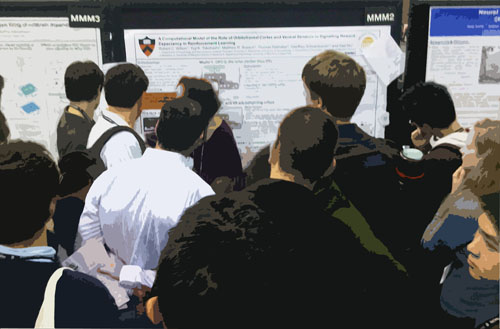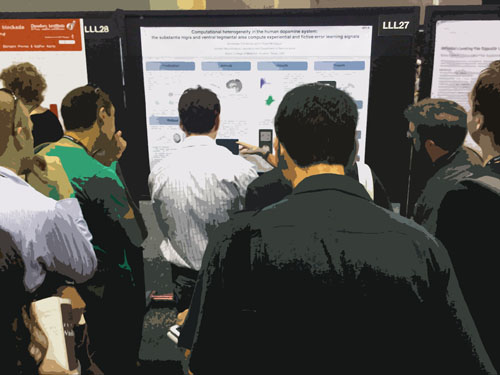Yesterday morning I checked out the technically-heroic dissection of mossy fiber function from the Tonegawa lab that employed a quadruple transgenic mouse: Mossy fiber input for pattern separation and pattern completion
*T. NAKASHIBA1, J. CUSHMAN2, K. A. PELKEY3, C. J. MCBAIN3, M. S. FANSELOW2, S. TONEGAWA1;
1The RIKEN-MIT Ctr. For Neural Circuit Genetics, The Picower Inst. For Lear, CAMBRIDGE, MA; 2Dept. of Psychology, UCLA, Los Angeles, CA; 3NICHD, NIH, Bethesda, MD
Using POMC-Cre to drive expression of tetanus toxin in dentate granule neurons the authors were able to inhibit synaptic transmission in the mossy fiber output of the dentate gyrus and investigate its role in pattern separation (defined behaviorally as the ability to distinguish fine spatial/sensory details) and pattern completion (ability to recreate a fully memory from partial cues). Interestingly, the transgenic model did not block transmission in new neurons aged 4-6 weeks-old and younger. This was demonstrated with a viral strategy, where newborn granule neurons were made to express both mCherry-VAMP2 and synaptophysin-GFP. Examining puncta in mossy fiber boutons it was clear that immature neurons had both red- and green-labeled boutons and that, with age, tetanus toxin degraded the fluorescently-labeled VAMP leaving only green boutons (the immunohistochemistry images were beautiful in this poster by the way).
So, with the model established, they went on to perform discriminative contextual fear conditioning as a test of pattern separation: mice were required to learn that one context predicted shock and another context did not. Surprisingly, given the often-cited role of the dentate gyrus in pattern separation and context discrimination, mice lacking mossy fiber transmission were better at this task. The pattern completion task was also contextual fear conditioning-based but used the immediate shock deficit (aka context pre-exposure facilitation effect) paradigm. Here, mice failed to learn to fear a context paired with shock if they spend only short amount of time in the context (here it was 10s I believe). However, pre-exposing the mice to the context several weeks earlier enabled control mice to learn despite the brief training experience (i.e. training/shocking with only brief cue exposure, they were able to “pattern complete” and retrieve the full memory of the context). But the mice lacking mossy fiber transmission were impaired at this task.
What the heck does this mean? Well, one possibility is that mature granule neurons/mossy fibers impair behavioral pattern separation and, upon inhibiting them, a pattern separation function of immature neurons is uncovered. This is a bit of a stretch I think. I wonder whether such a population of immature neurons (4 week-old neurons are just becoming functional) could have a significant impact. But it’s possible and would be fascinating to test whether eliminating this additional population would change the behavioral phenotype. These findings also seem at odds with previous studies from the same group showing that NMDAR dysfunction in the dentate gyrus leads to impaired context discrimination rather than the improved context discrimination observed here. Then again, blocking NMDARs is a completely different type of lesion than blocking an entire output pathway…in any case, I think we can agree – great food for thought.
And now time for PPP!
Maybe I have no idea what’s interesting or important. To obviate this potential problem, here are Photos of Popular Posters. What everyone else found interesting. In the MMM/LLL area…
 A computational model of the role of orbitofrontal cortex and ventral striatum in signalling reward expectancy in reinforcement learning. I walked by this poster twice – each walk separated by about and hour and both times PACKED! You will notice the high degree of chin-touching in the audience – an additional measure of popularity that I will include in SFN2011’s reporting (once I get the method down).
A computational model of the role of orbitofrontal cortex and ventral striatum in signalling reward expectancy in reinforcement learning. I walked by this poster twice – each walk separated by about and hour and both times PACKED! You will notice the high degree of chin-touching in the audience – an additional measure of popularity that I will include in SFN2011’s reporting (once I get the method down).
 The human substantia nigra and ventral tegmental area compute experiential and fictive error learning signals. Congrats – big crowd especially considering that, as far as I know, there’s not even adult neurogenesis in these brain regions!
The human substantia nigra and ventral tegmental area compute experiential and fictive error learning signals. Congrats – big crowd especially considering that, as far as I know, there’s not even adult neurogenesis in these brain regions!
For the Nakashiba poster, could the CA3 be doing something? Michael Hasslemo proposed that high levels of ACh in CA3 could allow for interference free encoding? Maybe by inhibiting MFs the pattern separation capacity of CA3 alone could be unmasked?
Right – good point. CA3 (in normal unlesioned, untreated animals) has been shown to both act as a pattern separator and a pattern completor depending on the stimuli. Eliminating 98% of MF inputs could extremely bias CA3 towards its pattern separation role. Another question I have is how this cool transgenic mouse model is different from traditional excitotoxic lesions or pharmacological inhibition of the DG. Obviously it is probably more specific but, in either case, you’re comparing two totally different circuits – due to compensation and adjustments in downstream circuits, enhanced discrimination in MF-silenced mice doesn’t mean the DG is not performing a pattern separation role under normal conditions.
Someone should really look at the changes in CA3 without these MFs. I once had an idea about this!
The poster makes the removal of the MF and the enhancement of pattern separation sound like a good thing. But I always keep in mind that excessive pattern separation will lead to a lack of generalization between memories. Imagine being able to learn how to open a door in the living room, but will have to relearn how to do so in the kitchen!
Very nice blog. Luckily, I discovered it just in time for my defense. Thanks for all the great work!
Hope it helps! What are you studying, may I ask?